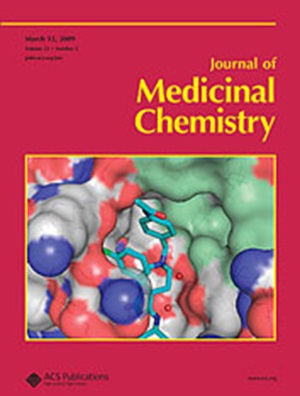Discovery of ZN-c5, an Orally Bioavailable Selective Estrogen Receptor Degrader (SERD) with Improved Pharmacokinetics.
IF 6.8
1区 医学
Q1 CHEMISTRY, MEDICINAL
引用次数: 0
Abstract
Here, we report our strategy to design an optimized oral selective estrogen receptor degrader (SERD), including human pharmacokinetics, by exploiting the bicyclo[1.1.1]pentane (BCP) ring system. The BCP has been shown to serve as a surrogate for phenyl rings and alkyl groups in drug candidates, reducing metabolism and improving physicochemical properties. It has not been extensively profiled in human clinical trials. We optimized a number of molecules and ultimately selected compound 4, which showed excellent cell potency in breast cancer lines and displayed highly favorable in vitro ADME properties across multiple species. This translated into highly desired exposure in vivo across both rodent and nonrodent species exceeding that observed with other contemporary SERDs and downregulators. After fully profiling the compound, we nominated compound 4 (ZN-c5) for clinical development. Compound 4 advanced into Phase 1/2 clinical trials, which demonstrated high human exposure upon dosing patients with 50 mg once a day.具有改善药代动力学的口服选择性雌激素受体降解剂ZN-c5的发现。
在这里,我们报告了我们的策略,设计优化口服选择性雌激素受体降降剂(SERD),包括人体药代动力学,利用双环[1.1.1]戊烷(BCP)环系统。BCP已被证明可作为候选药物中苯环和烷基的替代品,减少代谢并改善物理化学性质。它还没有在人体临床试验中得到广泛的描述。我们对许多分子进行了优化,最终选择了化合物4,它在乳腺癌细胞系中表现出优异的细胞效力,并在多物种中表现出非常有利的体外ADME特性。这在啮齿动物和非啮齿动物物种中转化为高度期望的体内暴露,超过了其他当代serd和下调因子所观察到的暴露。在对化合物进行全面分析后,我们提名化合物4 (ZN-c5)进行临床开发。化合物4进入1/2期临床试验,每天给患者50mg,人体暴露量高。
本文章由计算机程序翻译,如有差异,请以英文原文为准。
求助全文
约1分钟内获得全文
求助全文
来源期刊

Journal of Medicinal Chemistry
医学-医药化学
CiteScore
4.00
自引率
11.00%
发文量
804
审稿时长
1.9 months
期刊介绍:
The Journal of Medicinal Chemistry is a prestigious biweekly peer-reviewed publication that focuses on the multifaceted field of medicinal chemistry. Since its inception in 1959 as the Journal of Medicinal and Pharmaceutical Chemistry, it has evolved to become a cornerstone in the dissemination of research findings related to the design, synthesis, and development of therapeutic agents.
The Journal of Medicinal Chemistry is recognized for its significant impact in the scientific community, as evidenced by its 2022 impact factor of 7.3. This metric reflects the journal's influence and the importance of its content in shaping the future of drug discovery and development. The journal serves as a vital resource for chemists, pharmacologists, and other researchers interested in the molecular mechanisms of drug action and the optimization of therapeutic compounds.
 求助内容:
求助内容: 应助结果提醒方式:
应助结果提醒方式:


